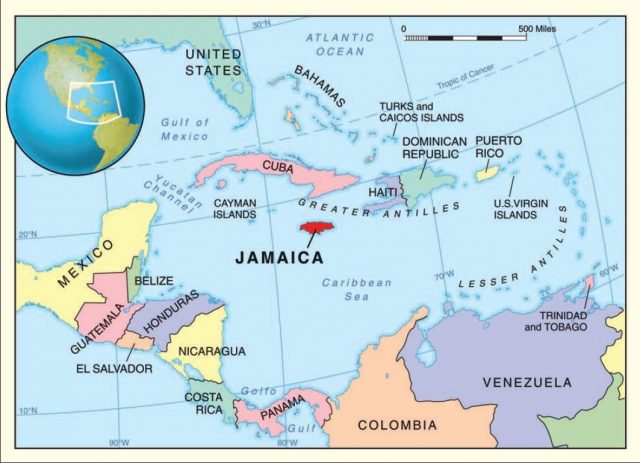Introducing Jamaica
On a blustery January day, would you like to be on a tropical island? Come to Jamaica, a country of sun-drenched beaches, warm tropical breezes, and a rich cultural heritage. Jamaica is an island nation and a close neighbor of the United States. It is a masterpiece of tropical splendor and extraordinary vistas. The natural landscape is filled with the multicolored hues of exotic plants and flowers and is subdued by the various green shades of dense rain forests, woodland and grass-covered meadows, and misty valleys. Countless cascading waterfalls tumble down from the mountainous interior, feeding the rivers, which spread out like hundreds of fingers across the island. White sand beaches rim the north and west sides of Jamaica, and the scenic Blue Mountains dominate the eastern side of the country. Jamaica is a great place for a vacation, and the island paradise attracts thousands of visitors each year.
Jamaica is located in the southwest Caribbean Sea, only about 550 miles (885 kilometers) south of Miami, Florida. It is the third-largest island in the Greater Antilles, the island chain that also includes Cuba, Hispaniola, and Puerto Rico. Because it is so close to the United States, you or someone you know may have been to Jamaica. What did you notice, or what did people tell you about the country? Did you know that the national motto of the country is “Out of many, one people” and that it speaks to the ethnic diversity of Jamaica? The majority of Jamaicans are of African descent, but there are well established, although relatively small, East Indian, Chinese, Arab, and European communities as well. Jamaican culture draws from all these groups. Popular culture, however, is heavily influenced by Jamaicans' African heritage, and formal behavior is unmistakably British in style.

The islands of the Caribbean form stepping stones that stretch in an arc from the western end of Venezuela in South America to the peninsula of Florida in the United States. The Caribbean Islands are divided into two groups: the larger, east-west situated Greater Antilles, which form the northern part of the arc, and the smaller, north-south aligned Lesser Antilles, which form the eastern part. The Greater Antilles include the four large islands of Cuba, Hispaniola (made up of the countries of Haiti and the Dominican Republic), Jamaica, and Puerto Rico. The Lesser Antilles are made of numerous smaller islands, including groupings known as the Windward and Leeward islands, as well as Barbados, Trinidad and Tobago, and the French Islands of Guadeloupe and Martinique.
“West Indies” is the name given to island nations in the Caribbean that have English as the official language and are members of the British Commonwealth. Jamaica is the largest of the English-speaking West Indian islands. It has an area of 4,244 square miles (10,991 square kilometers), making it slightly smaller than the state of Connecticut. Of that, 4,182 square miles (10,832 square kilometers) is land area and a relatively small area of 62 square miles (160 square kilometers) is water. The island measures 146 miles (243 kilometers) from east to west and is 51 miles (80 kilometers) at its point of greatest north-south width. The distance from Kingston, the capital, located on the south coast, to Annotto Bay, the nearest point on the north coast, is a mere 22 miles (36 kilometers).
Jamaica's nearest neighbors are Cuba, 90 miles (150 kilometers) to the north, and Haiti, 100 miles (160 kilometers) to the east. Centrally situated in the Caribbean region, it lies on direct sea routes from the United States and Great Britain to the Panama Canal.
Jamaica is divided into three counties and 14 parishes. Each parish has a main town, in which the government offices for the parish are located. Kingston, founded in 1692 after a violent earthquake devastated the city of Port Royal, became the country's capital in 1872. Previous British capitals were Port Royal and Spanish Town.
Spanish Town, named for its Spanish settlers, is one of the oldest continuously occupied cities in the Western Hemisphere and is a major population center in Jamaica today. Kingston is the heart of island life. It is a modern, bustling, sprawling city that never seems to sleep. The city is situated on a wide plain with the sea to the south and the Blue Mountains as its backdrop to the north. Kingston and it neighboring parishes are highly urbanized and draw their population from all over the island. As long ago as the 1970s, the question was asked, “How many people can this part of the island provide living space for?” The answer was far fewer than the number of people who want to come to the capital to live and work.
Jamaica is a country of contrasts. It has a multitude of problems such as urban sprawl, poverty, crime and violence, a depressed economy, and high foreign debt. Yet it is country of incredible scenic beauty, with many natural resources and a rich cultural life. Through the pages of this book, you will travel through Jamaica's varied and beautiful natural landscapes, study the country through time, and learn about the island nation's people, culture, government, and economy. You will get a glimpse of what life in Jamaica is like today, and you will gaze into a crystal ball to project the country's future.